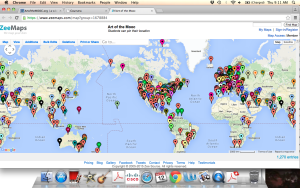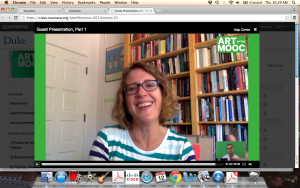114 countries, 29 guest speakers, 2 teachers, 4,000+ enrolled participants
 These are some of the elements of the Art of the MOOC, a Massive Open Online Course or MOOC, designed by artist and Duke University professor, Pedro Lasch, and co-taught with Creative Time chief curator, Nato Thompson. The course is available from October 19 to December 6, 2015 and offered on a Coursera landing page. There’s an accompanying wiki, artofthemooc.org, that features projects, biographies, a glossary and readings on socially-engaged art.
These are some of the elements of the Art of the MOOC, a Massive Open Online Course or MOOC, designed by artist and Duke University professor, Pedro Lasch, and co-taught with Creative Time chief curator, Nato Thompson. The course is available from October 19 to December 6, 2015 and offered on a Coursera landing page. There’s an accompanying wiki, artofthemooc.org, that features projects, biographies, a glossary and readings on socially-engaged art.
Lasch and Thompson envision the course as both a class and an art project. In their words, “ART of the MOOC functions simultaneously as a socially-engaged public art form and a survey course on that very subject.” Each week, these two teachers give a lecture that offers historical perspectives, keyword definitions, and descriptions of projects by artists such as Tania Bruguera, Sharon Hayes, Suzanne Lacy, and Rick Lowe. Bruguera, Hayes, Lacy and Lowe also appear as guest speakers, along with 25 other artists, curators, and theorists, including Associate Vice Chancellor for the Arts + Design, Shannon Jackson.
Complementing these lectures and conversations, creative projects are assigned with students given a choice of creating a “social method” project or a “flash mob option.” These weekly projects are shared and assessed by peers, and instructors Lasch and Thompson describe these activities as moments where participants are contributing “to the field by completing creative assignments and participating in collective art projects.”

During week 4, entitled “Aesthetics, Art History and Cultural Institutions,” guest presenters included Hans Haacke and Shannon Jackson. Haacke spoke about his project “Der Bevölkerung,” in Berlin’s Reichstag building, and different valences of the words “people” and “population” in German history. His work called attention to a heterogeneity of groups that have been excluded from German nationalist identities, and the work sparked a debate that ultimately led to a parliamentary decision during which government officials voted for the artwork.
Shannon Jackson’s appearance as a guest presenter followed Haacke’s. Seen in her office during a skype-conversation, Shannon Jackson is asked by Lasch, “One term I want to ask you about, and that may take people by surprise in your writing, but it’s a word I hope our students around the world will be thinking about quite seriously, is the word ‘support’… why does this term matter?” An excerpt of her response follows:
Shannon Jackson: “For me it actually has to do with a certain kind of political position. In histories around politically-engaged art or activist art I was concerned about the tendency to position the politically engaged artist as someone who was perpetually anti-institutional, that we are always trying to figure out how to take down the bureaucratic, oppressive, domineering institution, and there are so many important moments when we need to do that. At the same time I worried about the tendencies of that argument or stance, in that it plays into what we can now see happening locally, nationally, and globally, where a whole variety of conservative movements and new governance structures, are also anti-institutional, trying to roll back welfare programs, to make sure no one has health education, and public education is defunded. Maybe the politically-engaged artist should be talking about being pro-institution sometimes…
I was interested in that as a professor at UC Berkeley, watching how our historically activist campus also is navigating this discourse of being an anti-institutional, anti-machine university, appropriately for many occasions, and how we square that now with the public disinvestment in education. I’ve been interested in that paradox for a long time…
It seems to me that there is also a gender dimension to this. It’s partly about the institutions or systems or practices of care that we depend on are often invisible to you. That is a gendered argument. The term support was a way to raise some level of consciousness of our interdependent relationship to a wider support system that is either quite intimate or systemic and to avow that, to connect with the part of us that is not only about our autonomy and our individuation, but also about our interdependence…
That political position actually has parallels with a whole variety of conceptual art practice, or a lot of experimental art practice, where the dependence of the art object on its surround, on the background, on its pedestal, on its frame, is something that artists are challenging. There’s an effort to ask where does the art object begin and end, by exposing its interdependence on a support system. I became really interested in projects where that aesthetic, formal pursuit, which is such an interesting conceptual pursuit, could be joined to an alternate way of thinking about what we mean by political. The word support is both a political term and obviously it’s an aesthetic term as well.”
